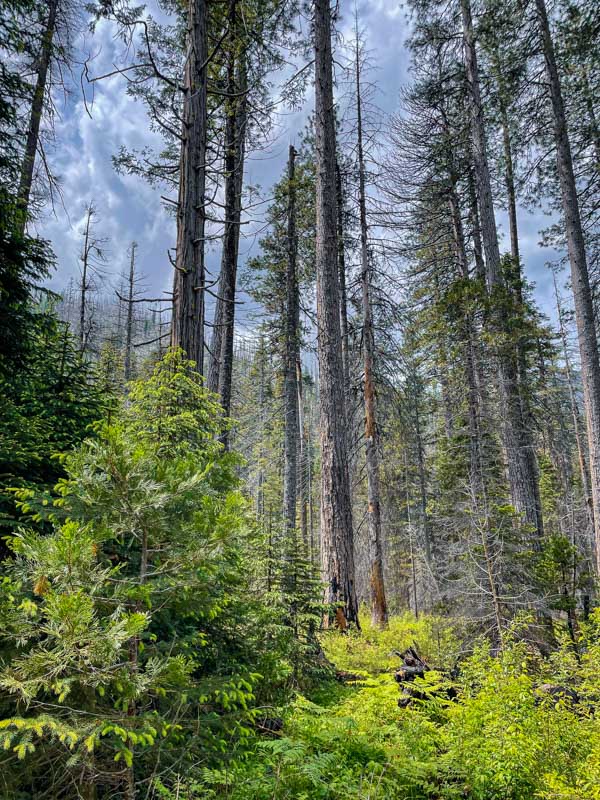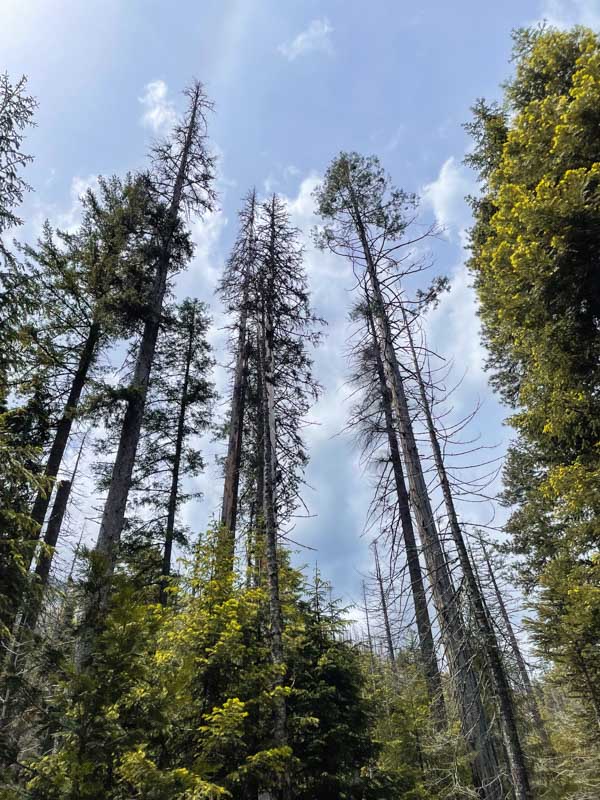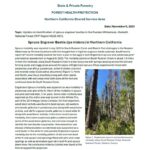In June 2023, my family and I took a trip up Russian Creek in the Russian Wilderness. This area is renowned for its conifer diversity so I was on the lookout for my favorite plants.
It was alarming to discover mortality in one of California’s rarest conifers, the Engelmann spruce due to Spruce Engraver Beetle in Northern California. Here is what I wrote:
It appears California’s Engelmann spruce are also under attack as the Blake’s Fork stand in the Russian Wilderness is witnessing ~60% mortality over the past few years from what I believe to be spruce beetles. More monitoring is needed.


Upon finding this, I wrote to Cynthia Snyder, Entomologist with the Forest Service, Forest Health Protection unit. Cynthia visited the stand three times after our discussion to diagnose the issues. She found:
- Heterobasidion occidentale infecting white fir and possibly spruce.
- Armillaria was also found in the white fir and spruce
- Englemann spruce was found newly down and still green foliage with piles of frass along the stem indicating colonization by Ips beetles. Samples were sent to California Food and Agriculture and confirmed to the earlier identification and forwarded on to Jim LaBonte at Oregon Food and Agriculture who identified them as Ips tridens.
From the report by Cynthia:
Spruce Engraver Beetle in Northern California
Ips tridens is distributed throughout the western spruce forests from Alaska to northern California and east to the Rocky Mountains where it attacks Sitka, white, and Engelmann spruce. California records from the California Insect Survey include Crescent City (Del Norte County), on Picea sitchensis and 7 mi N. Callahan (Siskiyou County), on P. engelmannii (Bright and Stark 1973). It is most notable for its many aliases due to the polymorphic forms of the females (Furniss and Carolin 1977, Bright and Stark 1973).
Ips tridens, spruce engraver, is not considered economically important (Furniss and Carolin 1977) as its attacks are most often limited to weakened or windthrown trees. Outbreaks in standing, healthy trees are uncommon and considered short-lived. Spruce engraver beetles are usually found colonizing the upper surfaces of windthrown trees and broken tops. They are much more tolerant of sun-exposed surfaces than are spruce beetles and fresh piles of boring dust are key indicators of recent infestation. If external signs of infestation are present, removing a small section of bark will likely reveal the Y-shaped, frass-free galleries in the inner bark; the same pattern engraved on the face of the sapwood; and possibly various life stages (larvae, pupae, or adults) of the beetles (Furniss and Carolin 1977, Wood 1982, Wood and Bright 1992).
Flight begins in May in coastal areas where Sitka spruce, Picea sitchensis, dominates and mid-June in the mountains where Englemann spruce is found in California (Bright and Stark 1973). Attacks by re-emerging parent adults continue through July. As in other species of Ips, males locate suitable host material, initiate the attack, construct a nuptial chamber, and release a powerful sex pheromone which attracts both males and females to the breeding site. One to ten (typically four to six) females enter each nuptial chamber to construct egg galleries which approximately parallel the grain. Larvae mine for about 3 mm entirely in the phloem, often crossing over an adjacent egg gallery. They then continue the mine against the xylem and pupate about 5 cm from the egg gallery. Teneral adults feed in the brood material through the summer, often reducing the inner bark to a powder. If the host material becomes very dry, beetles will emerge to overwinter in the forest litter (mountain and coastal populations) or possibly to initiate new attacks (coastal only). Otherwise, the beetles will overwinter in situ. There are typically two to three generations per year (Bright and Stark 1973, Furniss and Carolin 1977, Wood 1982, Wood and Bright 1992).
Management of spruce engraver beetles is typically not necessary in general forest settings, although prudent and timely slash management directed at spruce beetle prevention might also serve to reduce spruce engraver beetle populations. In the Russian Wilderness, spruce engraver beetle has been detected in the past and is currently active, but control is not recommended due to the restrictions on designated wilderness areas and other stress factors at play (drought and root disease).

Hey Michael…did you see any new infestation or mortality in the weeping spruce? In my experience, in a normal year very few insects are found in cambium or cones. Fire and chainsaws seem to be its current challenge.